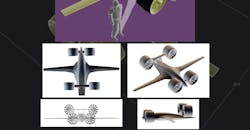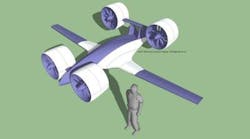Unmanned aerial aircraft (UAVs) have already made a trip across the Pacific Ocean (the RQ-4 Global Hawk). But Sabrewing Aircraft Co. is a company with a vision that cargo UAVs can make that trip on a regular basis to transport goods when needed without a human pilot. The company recently raised 140% of its initial angel funding goal, according to Ed De Reyes, CEO of Sabrewing Aircraft .
“We will close this round shortly, and cap this round at just under $1 million,” De Reyes noted, crediting The Drone Fund, Integro Ltd., and two other investors for the financial accomplishment. The Drone Fund is a $90 million investment fund started by Japanese investors to encourage drone startup companies and help establish a drone ecosystem in Japan and the U.S.
Sabrewing Aircraft is building a long-endurance, high-cargo-capacity demonstrator UAV that will be 65% the size of their final UAV design. It will compete in the Pacific Drone Challenge and serve as a demonstrator for commercial and U.S. Department of Defense purposes.
The Draco-2 is a 65% version of a unique, long-distance UAV meant to serve civilian and military trans-oceanic cargo transport requirements.
The UAV has been called “The Draco-2” and is a truly long-endurance aircraft, with a flight distance to 5000 miles (9200 km), flight time to 50 h, and flying at altitudes to 22,000 ft. (6700 m). It is being readied for a long-distance flight from Japan to Silicon Valley in Northern California. The battery-less, gas-electric hybrid (see figure) can carry up to 3,000 lb. of cargo. The full-scale version will have similar flight capabilities but be capable of carrying a larger payload.
The full-scale UAV that Sabrewing is planning will be about the size of the Cessna-208 (Caravan) or Quest Kodiak, with similar acquisition costs and operational speed, but with almost double the payload of either aircraft. The UAV is being designed primarily to serve both military and civilian cargo operations and is priced well below the Caravan’s or Kodiak’s operating and maintenance costs, yet provides much greater range and payload.
“We’re building a drone that can fill the role of a mid-altitude, long-endurance cargo UAV” De Reyes commented. “Our team has previously built a large-scale, manned air vehicle about the size of our demonstrator. Now we’re taking the data and experience that we’ve gathered and building a UAV that can incorporate autonomy, economy, endurance, and reliability.”
About the Author
Jack Browne
Technical Contributor
Jack Browne, Technical Contributor, has worked in technical publishing for over 30 years. He managed the content and production of three technical journals while at the American Institute of Physics, including Medical Physics and the Journal of Vacuum Science & Technology. He has been a Publisher and Editor for Penton Media, started the firm’s Wireless Symposium & Exhibition trade show in 1993, and currently serves as Technical Contributor for that company's Microwaves & RF magazine. Browne, who holds a BS in Mathematics from City College of New York and BA degrees in English and Philosophy from Fordham University, is a member of the IEEE.


